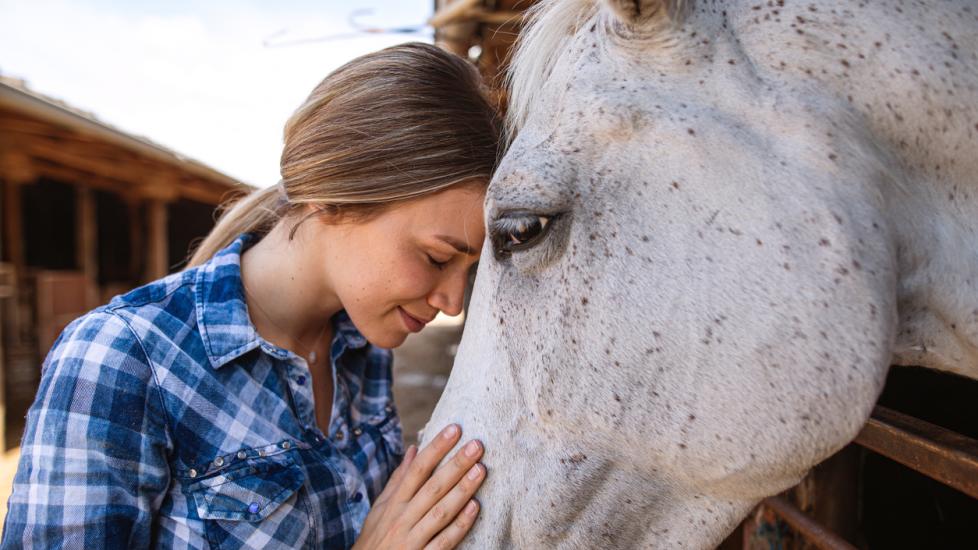How to Read a Horse's Body Language
Communication is an essential part of our lives, but not all communication is verbal. We can communicate with our horses through the use of body language. By being perceptive, we can learn what they are trying to tell us. And make no mistake, they can read human body language too.
Learn how to read our horses from front to back:
Ear Body Language
We can learn a lot about how a horse is feeling by looking at his ears. If they are forward, it means they are alert and taking in new information in a friendly manner. Horses can move their ears in 180 degrees to receive information from all directions.
Ears that are erect and facing backward means they are listening to something behind them. However, when the ears are pinned down and backward–this is a sign of fear, aggression, stress, or pain. Proceed with extreme caution around the horse if you notice this behavior.
Rapidly flicking their ears back and forth indicates a horse’s heightened state of alertness. He may be trying to locate a frightening or concerning sound; or be overstimulated. Horses have an extremely good sense of hearing and can hear things over a mile away.
If the ears are hanging to the side in a drooping manner, a horse is relaxed, bored, and may be dozing off to sleep. If you need to approach your horse at this time, do so carefully as not to startle them out of sleep.
Eye Body Language
The white part of your horse’s eye is called the sclera. Be careful if you see the sclera of your horses’ eyes showing. It means he is afraid, startled, or very nervous. A happy and relaxed horse will have his eyes wide open, but the sclera not showing. One caveat is that Arabian and Appaloosa sclera is routinely visible.
If the eyes are rapidly darting back and forth, that means a horse is nervous and looking for a way to escape. When your horse is anxious or in pain his eyes will be open with tense muscles above the eye making upside-down, V-shaped wrinkles.
A half-closed eye could indicate your horse is tired, relaxed, the sun is bothering his eyes, or that something hurt his eye. Often, a horse with an abrasion on the eye (called a corneal ulcer), or something stuck in their eye will hold the eye half closed and clamp it shut tightly if you try to investigate. If your horse is holding one eye half closed longer than would be expected for a nap, or when the sun is not in his eyes, contact your veterinarian immediately.
Muzzle Body Language
A horse’s muzzle is a very expressive feature. A horse that is bored or at rest will have a droopy muzzle, with the bottom lip hanging loosely from their teeth. This should correct when the horse starts to work. If it does not, it could indicate a neurologic problem that needs to be seen by your veterinarian.
A horse with a pursed muzzle caused by tension around the mouth indicates stress, or fear. At this time, they may also flare their nostrils. Curious horses will sniff and blow air out of their nostrils, almost making a snorting sound.
A horse that looks like they’re chewing is a good sign because that means they’re thinking. Foals will make a characteristic smacking noise to let others know they are young and harmless and just want to be noticed.
A unique behavior that horses do with their muzzles is called the flehmen response. During this maneuver, a horse will raise his head, curl his upper lip backward and breathe in deeply. This helps them process certain smells and hormones. This behavior is seen often when stallions are trying to decide if a mare is in heat.
Leg Body Language
Horses use their legs to do more than just get around. They can use them to let us and other animals know what they are doing.
A bored or resting horse will often have one hindlimb propped forward resting on the ground, sometimes crossed one over the other. An alert or curious horse will stand squarely. An angry or annoyed horse will stomp, strike, or kick. Most horses will give a warning kick before a full strike but not all of them will lend this warning first.
Pawing is a natural behavior associated with thwarted feeding and drinking. Equine behaviorists have documented that when horses reach a body of water, they tend to paw at it or roll in it. This pattern is repeatable and well documented, but not well understood.
Tail Body Language
From tip to tail, horses use every part of their body to communicate. A tail that is clamped down indicates fear or aggression, indicating he is about to bolt or kick. Irritation and frustration are also exhibited by a violently switching or flicking tail.
A gentle swish is often just to deter flies and other insects. A raised tail signals, excitement and curiosity. When riding, a tail that is slightly raised and swings loosely is desirable. A relaxed horse’s tail will dangle gently.
While each part of the body helps your horse to communicate, it is important to “read” the horse’s total body language together to get a full picture of what they’re trying to communicate.
Featured Image: iStock.com/FluxFactory
